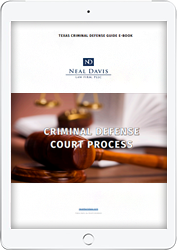
The Federal Criminal Offense Timeline
6 steps of the federal criminal justice system
Being subjected to the federal criminal investigation process can leave you wondering when it will ever end. If you are the subject of an investigation, have been charged with an offense or are a witness, it may help to know a bit about the timeline that cases commonly follow.
Let’s take a look at the federal criminal case timeline and the basics you should know.
1. Initial complaint (arrest)
Some form of concern about criminal activity is necessary for a case to get rolling. This can originate from 1 of 4 possible sources:
- A criminal complaint
- An arrest
- An indictment
- Criminal information
Criminal complaints usually arise from ongoing investigations of activities. For example, a DEA agent might wonder how drugs are getting on the street in a specific area without initially knowing who’s responsible. As they follow the evidence to the people they believe are responsible, they may hit a threshold for filing charging documents. Evidence is either presented to a prosecutor or the officer in charge of the case proceeds to get an arrest warrant.
A warrantless arrest is the fastest way to end up in criminal court. While arrests often arise from criminal complaints, they may also happen only after an act has occurred. The arresting officer will have to present an affidavit supporting the arrest.
Indictments come from extensive investigations. A grand jury was convened at some point to determine that there was enough evidence to charge you with a federal crime.
The term criminal information is used to describe when a person has admitted to a crime and is prepared to plead guilty. Supporting documents are sent by a prosecutor to the court to present the case and get it moving.
2. Court involvement
With the exception of a few instances involving the issuance of warrants or the convening of grand juries, you’ll see that a judge hasn’t really been involved up to this point. If charges have been filed based on 1 of the 4 initial types of complaints, you will now be asked to go before a judge.
If the case arose from a criminal complaint or an arrest, an initial hearing will be held to discuss whether there’s enough of a case to move forward. Several things occur at this hearing, including:
- A reading of the charges
- Setting bail conditions
- Informing the defendant of their rights to remain silent and have counsel
- Selection of counsel
3. Arraignment
Eventually, all cases head to arraignment. Under the Federal Speedy Trial Act of 1974, you have a right to insist the trial begins no later than 70 days after your first court appearance. You can waive this right in order to obtain continuances.
If your case came into the system by way of indictment or criminal information, everything that would normally have been done during the initial hearing will have to be done during the arraignment. You will also be asked how you plead to the charges.
At the end of the arraignment, bail conditions must be met. If you’ve been deemed a threat or a flight risk, you will be remanded to prison. The same applies if you can’t afford to post bail. Otherwise, you will be remanded to your own custody. Bail conditions may include:
- Limits on where you may go
- Reporting requirements
- Electronic monitoring
- In-person check-ups by federal officers
4. Pre-trial
With a trial looming, the defense now has access to one of the most important criminal process steps. Discovery is the stage where both sides have to disclose the evidence they want to present. This means your attorney will finally get to look at the case against you. By law, the government must include anything that helps the defense, too.
Following discovery, things tend to start moving with pre-trial motions. If the government’s case is fundamentally flawed, a motion to dismiss and end the case may be filed. If the government has a rock-solid case, a defendant might be offered a plea agreement. Questions about admissible evidence and testimony are also raised during this period. Only 2 percent of federal criminal cases will ever make it to trial.
5. Trial
First, the format of the trial must be decided. You can elect to be tried by a jury, or you may seek a bench trial where the judge determines guilt. If you choose a jury trial, a jury will have to be selected.
Hearings are scheduled and conducted, usually lasting from one day to a couple weeks, to allow evidence and arguments to be presented. Upon completion of the hearings, deliberations occur and lead to a finding.
6. Post-trial
If a defendant is found guilty, they must be sentenced by the judge. Those found not guilty will be released, and any bail will be returned. If you believe a question of law led to a flawed outcome, you do have the right to file an appeal.
The federal criminal process can be confusing and complicated. It’s in your best interest to have an experienced and trained attorney on your side who is knowledgeable about federal crimes. Contact the Neal Davis Law Firm today to schedule an appointment.
Criminal Defense Court Process
FREE E-BOOKLearn all about the legal process and your legal rights.

